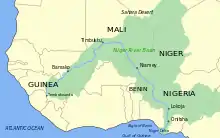Anambra River
The Ọmambala River flows 210 kilometres (130 mi) into the Niger River and is found in Anambra, Nigeria. The river is the most important feeder of the River Niger below Lokoja. The flow of the Ọmambala River is released into the Atlantic through various outlets forming the 25,000-square-kilometre (9,700 sq mi) Niger Delta region.[2]
| Ọmambala River | |
|---|---|
| Native name | Osimiri Ọmambala |
| Location | |
| Country | Nigeria |
| State | Anambra State |
| Local Government Areas | Anambra East, Anambra West, Ayamelum |
| Physical characteristics | |
| Mouth | Niger River |
• location | Onịcha, Onịcha úgwú, Anambra State |
| Length | 256 km (159 mi) |
| Basin size | 2,751 sq mi (7,130 km2)[1] |
| Discharge | |
| • location | Onịcha |
Omambala Region and Culture:
Omambala, the name of ancient Goddess whose river journeys from a place called uzo-uwa-ani underworld to Anam and Onicha axis, where it connected with Nkisi & Niger-kwora/mgbakili Rivers, according to the indigenous people; in their journey to the Atlantic ocean.
There are several myths & mysteries surrounding Omambala which lead to different interpretations by many tribes and nationalities, hence the mispronounciation of Omambala as Anambra by the earlier European explorers.
Before the creation of States, Omambala was formally used to refer to the area; comprising present-day Anambra, parts of Kogi, Enugu and Ebonyi States by the indigenous people of that area. Currently, indigent people from Aguleri, Anam, Nsugbe, Umueri, Anaku, Nteje, Umunya, Nando, Igbariam, Nkwelle-Ezunanka, Nzam, Awkuzu, Ogidi, Ogbunike, Ayamelum clan, etc make proprietary claims to the Omambala heritage.
Omambala People have distinct dialects, customs, traditions and ethnophilosophical values with many mystical & esoteric belief systems that place premium value on spiritualism over capitalism; and are held together by eternal bond of custom, language, religious tradition and the Omambala River. This is due to the strong bond and attachment that exist betwixt them and their natural-cosmology and ecosystem. In the views of ndi-Omambala just like most Africans; they believe the universe to be alive {living} and can be related to, through rituals & covenants. Ndi-Omambala have myriads of arts, songs, folktales, legends, myths, masquerades, deities, superstitions, etc with which they substantiate their faith in God and traditions. Most of them are Animists & traditionalists or ATR, even though many of them use other religions & cults as a means to attainment. They are related to Jews in their religious rituals and worship, probably due more to history according to ancient lores.
The socio-economic, socio-cultural & socio-political influence of the Omambala Region extends to parts of Edo, Delta, Imo, Rivers, Abia, Taraba, Benue, Niger, Nasarawa, Plateu, Akwa-Ibom & Cross-Rivers States of Nigeria and as far as Niger, Chad, Cameroon, Mali, Central Africa Republic, etc.
The main occupations of the Omambala people are hunting, military, fishing, agriculturalists/farming, trading, artisanship, herbalism, poetry, divination, etc
Prominent Leaders from Omambala Region include:
- Chief Nnamdi Azikiwe
- Chief Akanu I am
- Chief Michael Okpara
- Chief Odumegwu Ojukwu
- Chief Chukwuemeka Ojukwu
- Chief Alvan Ikoku
- Chief Nwafo Orizu
- Chief Alex Ekwueme
- Chief John Mmadukasi
- Chief Jaja Nwachukwu
- Chief Chuba Okadigbo
- Chief Chinua Achebe
- Chief Emeka Anyaoku
- Chief JC Emeka
- Philip Emeagwali
- Kenneth Dike
- Alexander Mmaduebo
- C.C Onoh
References
- Anyadike, Raymond N. C.; Phil-Eze, Phillip O. (1989). "Runoff Response to Basin Parameters in Southeastern Nigeria". Geografiska Annaler. Series A, Physical Geography. Blackwell Publishing. 71 (1–2): 75. JSTOR 521009.
- Shahin, Mamdouh (2002). Hydrology and water resources of Africa. Springer. pp. 307–309. ISBN 1-4020-0866-X.
